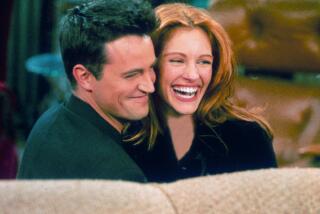Taraji P. Henson and the ‘Hidden Figures’ cast make a case for feel-good seriousness at TIFF
Reporting from Toronto — Five years ago, “The Help” became both a box-office phenomenon and an Oscar best picture nominee by toeing the line between lighthearted camaraderie and social seriousness among Southern women of color.
The upcoming “Hidden Figures” — a fact-based 1960s-set film about barely known NASA ladies whose calculations helped put Americans on the moon — diverges in plenty of ways from that Tate Taylor smash. But it’s hard to avoid the similarities — tonally, thematically and Octavia Spencer-ishly. (She brings her arid wit to each.) Tears and laughter are meant to commingle in each film; they’re stories of unity in times of segregation.
On Saturday at the Toronto International Film Festival, Fox took the wraps off several key scenes from the Theodore Melfi movie, which counts Pharrell as its producer and musical contributor. It also brought out three of its leading ladies — Spencer, Taraji P. Henson and Janelle Monáe — to talk up the movie’s importance.
Or, in Henson’s case, just to tear up.
“The reason this is so overwhelming is when you come from a place with no dreams and no hope and you see people like you have no place in society...” Henson said, her voice trailing off as she choked up on one of several occasions. “If I knew about these women [growing up], maybe I would have aspired to be a rocket scientist.”
A moment later, she said, through more tears, “Sorry I’m so emotional,” as she paused to wipe her eyes. “My makeup is running. I should have done an Alicia Keys and taken it off.”
See the most-read stories in Entertainment this hour »
Henson plays Katherine Johnson, a remarkable person even before you come on to the prejudice and racist hurdles she overcame. Johnson spent decades innovating at NASA, using such tools as analytical geometry and celestial navigation to calculate trajectories in ways that landed Apollo 11 on the moon and enabled the space program to reach greatness for years.
And she did it as an African American woman in a Jim Crow era when even using the same water fountain or restroom as white colleagues was not allowed. (The latter provides a tragic-funny moment in the footage shown, in keeping with the general feel-good serious tone of the film).
The scenes on display in Toronto all managed to send out those currents: the trio of women with a car broken down on the side of a road and encountering a skeptical and possibly misogynistic white police officer; Johnson’s first interactions with the high-level team in charge of putting John Glenn into space, in which she wins over a boss (Kevin Costner) and elicits jealousy from a small-minded colleague (Jim Parsons, also the star of Melfi’s Intel commercials).
But far from a period piece, the cast sees this as a modern story. “This movie represents what we should be thinking right now,” Henson said. “How do we make this world a better place?”
Added Monáe. “It transcends race...Superheroes can be real; they can be women. There can be new superheroes in ghettos around the world.”
FULL COVERAGE: Toronto Film Festival »
Pharrell said he joined the project because of that triumph. “You realize women were dreaming of engineering in a matrix where the odds were stacked against them,” he said. “How could you not want to be a part of it?”
(Beyond the cultural importance, Henson had a simple reason for taking the part: “I needed a departure from Cookie,” she said, alluding to her “Empire” character.)
Will the film be able to succeed commercially in the manner of “The Help?” It doesn’t, it should be noted, have the brand-recognition of a bestselling book. And dramatizing equations on-screen isn’t easy, especially when the people are ordinary, well-adjusted, non-John Nash types.
Still, Melfi (he previously directed the coming-of-age/Bill Murray tale “St. Vincent”) said he felt unhampered by the nature of characters’ jobs, and believed that the film could rise on the strength of its can-do characters and hard-won inspirational vibe.
“It’s a joyful, noncynical story of women and their progression in this world,” he said in a phone interview.
And their tasks, though land-bound, were thrilling in their way. “It’s a great story of getting us to the moon,” he said.
By setting itself in such a wonky world, “Hidden Figures” also departs significantly from many biopics about African Americans — and, for that matter, people of any race.
Henson said it’s precisely the characters’ jobs that make the movie necessary as a work of inspiration.
“Nowadays, people of color have sports, rap, acting,” she said. “And there’s so much more to be done.”
On Twitter: @ZeitchikLAT
ALSO
‘Tramps’ steals a little romance
Barry Jenkins’ ‘Moonlight’ makes the case for quiet eloquence
Young and dislocated, Devon Terrell on playing a young and dislocated Barack Obama
More to Read
Only good movies
Get the Indie Focus newsletter, Mark Olsen's weekly guide to the world of cinema.
You may occasionally receive promotional content from the Los Angeles Times.









